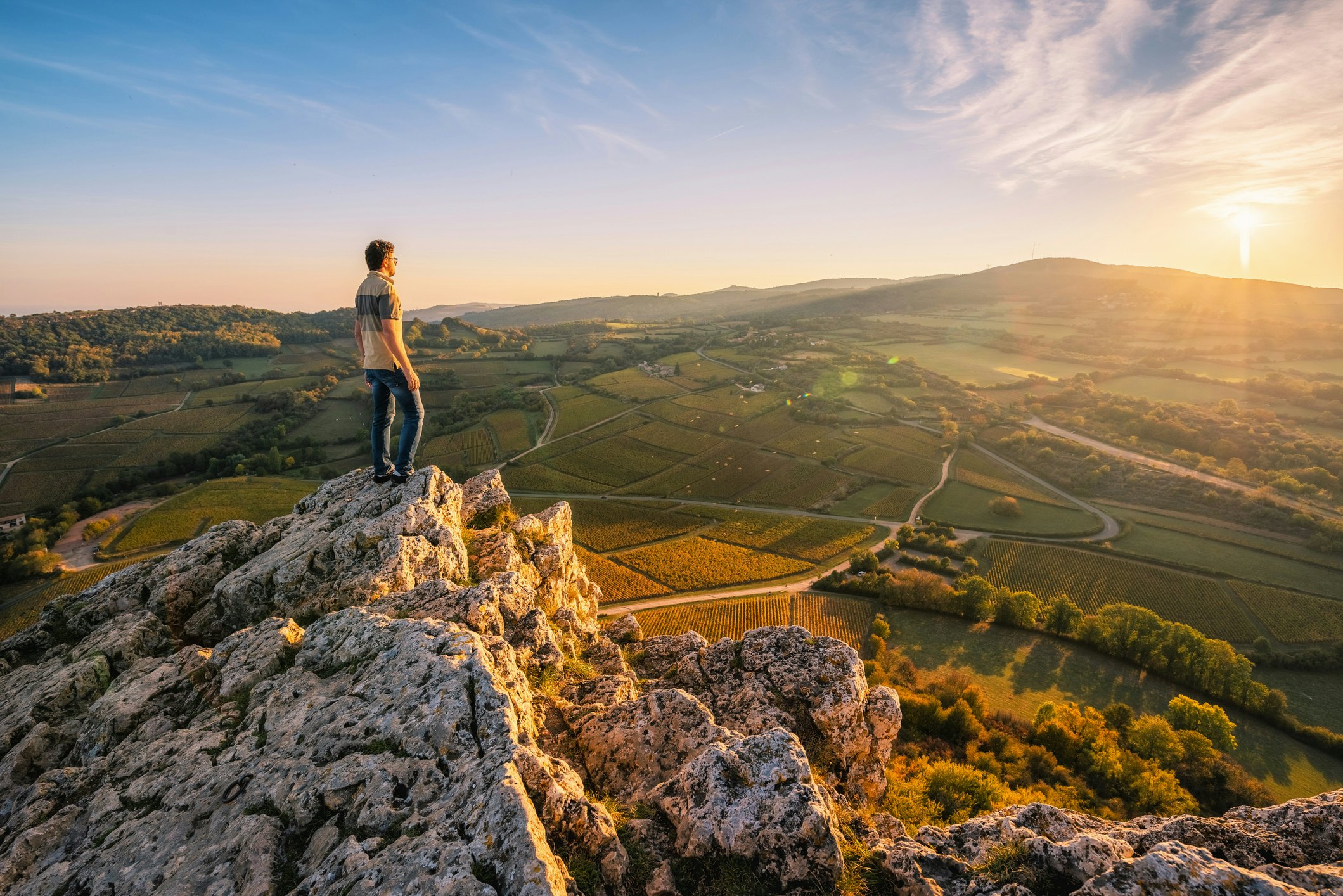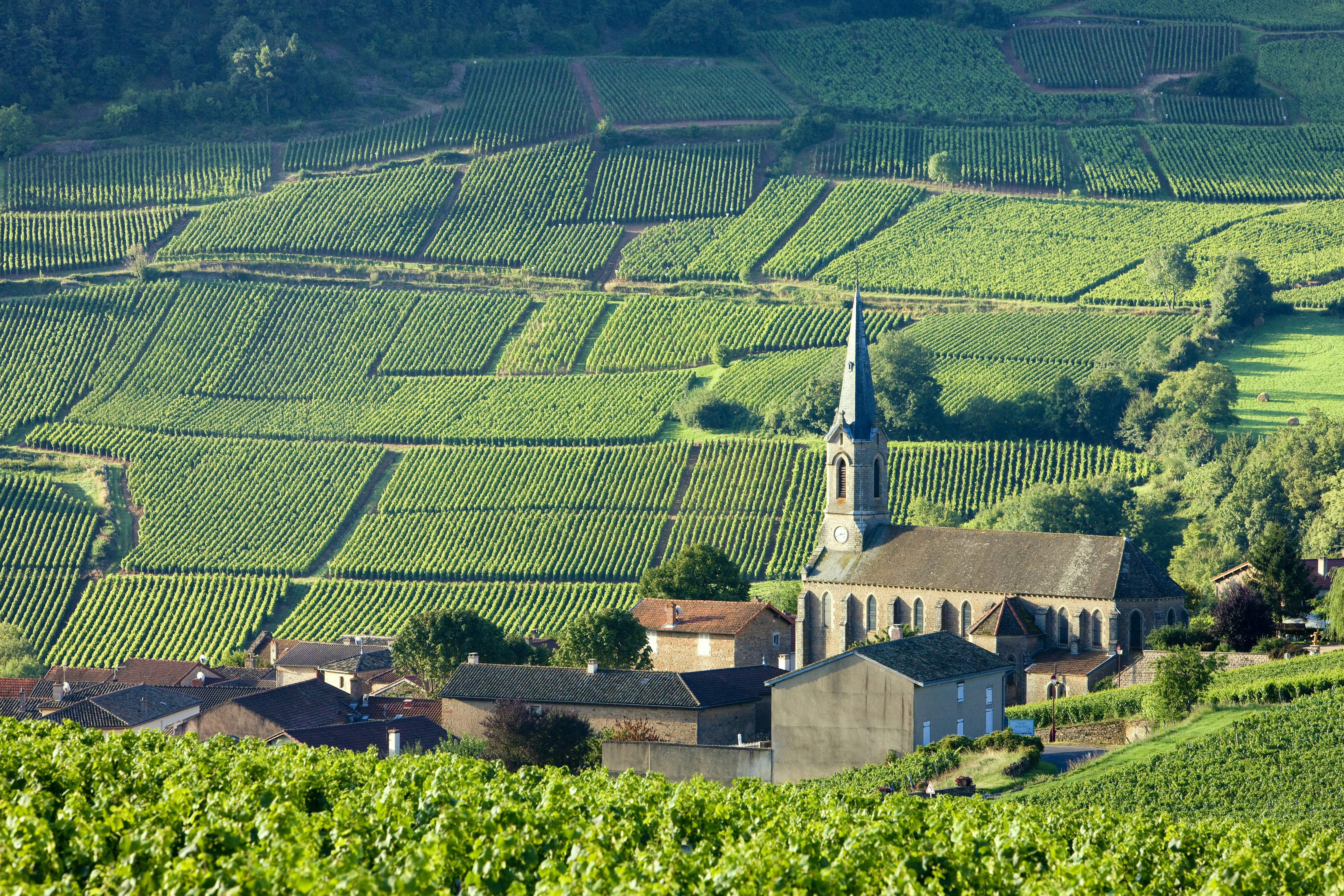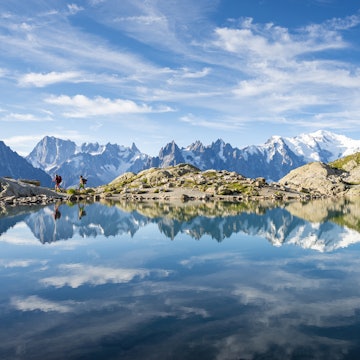
5 beautiful walks in Burgundy: vines, chateaux and Gallic drama

Nov 11, 2021 • 7 min read

The sprawling forests of Burgundy provide excellent walks and hikes © Drew Myers / Corbis / Getty Images
With sweeping vineyards peppered with medieval villages, emerald hills speckled with mustard fields, sprawling forests and wine-making traditions that hark back centuries, Burgundy was made for walking.
Some 6,000km (3,700 miles) of well-marked footpaths meander like spaghetti through this beautiful green region in eastern France, serving up an almost endless choice of trails. Whether it's one of the country’s legendary long-distance GR ("Grande Randonnée") trails, a spiritual pilgrimage or a kid-friendly romp between the vines, there is a hike in Burgundy with your name on it.
Flat, smooth towpaths, some accessible to travelers with disabilities, cruise along Burgundy’s tranquil waterways, and peaceful voie vertes (green ways) allow walkers to steer clear of motorized noise. Whether you follow the valleys or traverse the hills, trekking with a donkey is a popular favorite for families (a donkey can carry your gear and, if necessary, small tired tots).
Useful websites for route-plannning include Burgundy Tourism and the Comité Départemental de Randonnée Pédestre de la Côte d’Or. Before you arrive, download the free Balades en Bourgogne app onto your phone to plug into fascinating audio histories of Burgundy villages and vineyards while you walk.
Sentier des Roches
Best cliff-top views
15km (9 miles) round trip, 5 hours, moderate
Burgundy's best vintages come from the vine-covered Côte d'Or (literally, "golden hillside"), running south from Dijon for about 60km (37 miles). Taking a memorable day walk in the southern section of this oenophile nirvana affords ample opportunities to gorge on decadent views. The trail begins in Orches, a village 13km (8 miles) southwest of Beaune, where vignerons have crafted exceedingly fine Côte de Beaune vintages since the Middle Ages.
The circular trail piggybacks on a section of the GR7 long-distance route and traces the path of the D171 along the dramatic crest of the Falaises de Baubigny escarpment. From here, there are spectacular bird’s eye views of hand-groomed vineyards, the River Saone and villages of toy-like houses constructed from golden stone, seemingly glued to the soaring cliffs.
The loop is peppered with attractive villages (Orches, St-Romain, Évelle, Baubigny, Dracy, to name just a few), which are great places to pause for a coffee or sample the area’s famous dry whites and delicate reds. Though it's closed to the public, Feudal Château de Rochepot, with its signature glazed-tile roof and sea of witch-hat spires, is a breathtaking sight. The village of La Rochepot has a couple of chambres d’hôtes (B&Bs) should you want to linger overnight; wine estate Domaine Guy Fouquerand is recommended.

La Roche de Solutré
Best family hike
4km (2.5 miles) round trip, one hour return, easy
You can follow in the footsteps of a French president when you trek to this spectacular craggy outcrop where swashbuckling bandits made mischief in the Middle Ages, and where French resistance fighters took shelter during WWII.
During his term in office, President François Mitterand walked up Solutré once a year, and weekending families continue to flock here year in, year out. Well-maintained gravel footpaths – rocky in spots but never steep – tango slowly up the imposing limestone outcrop, rewarding those who reach the 495m (1,624ft) summit with an all-round panorama of Burgundy’s celebrated Pouilly-Fuissé vineyards. On clear days, you can even spot the snow-capped dome of 4,808m (15,774ft) Mont Blanc in the Alps – it's quite magical at sunset.
Pick up the signposted trail next to the Musée de Préhistoire de Solutré, 8km (5 miles) west of Mâcon town in Solutré-Pouilly. Prehistoric horse fossils and engraved stones unearthed around Solutré suggest the mountain was inhabited as early as 28,000 to 10,000 BCE. The museum does a marvelous job of evoking the life and techniques of local hunters from this prehistoric period, today known as the Solutrean era after Burgundy’s most famous rock.

Trailing Vercingétorix from Bibracte to Alésia
Best historical route
120km (75 miles), 4 days, moderate
Visiting the Gallic oppidum (fortified village) of Bibracte is a rite of passage for Astérix comic book buffs. The hillside stronghold, 25km (15 miles) west of Autun on Mont Beuvray, was the capital of the Aedui Celts in the 1st and 2nd centuries BCE, and the spot where Vercingétorix was made chief of the Gauls in 52 BCE, shortly before being thrashed by Julius Caesar and 50,000 Roman legionaries at Alésia, 120km (75 miles) north.
Relive the battle at Bibracte’s Musée de la Civilisation Celtique before following this historic trail through the scenic Burgundy countryside in the footsteps of Vercingétorix and his legions to reach the actual battleground where the chieftain made his last stand, marked today with a superb museum and theme park.
High-drama history aside, the four-day hike to Alésia ribbons north through the kaleidoscopic Parc Natural Régional du Morvan – a protected patchwork of dense woodland, lakes and rolling farmland stitched together by green hedgerows and dry stone walls. Grab hiking and cycling maps and guides at the Maison du Parc in St-Brisson. Pretty canal views are abundant around the villages of Braux and Brianny, and chateau-clad Vic-sous-Thil and hilltop Flavigny-sur-Ozerain are two more swoon-worthy stops.
Voie de Vézelay
Best spiritual journey
80km (50 miles), 3–4 days, moderate
No route is more hallowed or historic than the pilgrimage along the Chemin de Saint Jacques de Compostelle, joining up with the Santiago de Compostela in Spain. Four different routes across France are detailed in the original Codex Calixtinus route guide, penned for pilgrims way back in the 12th century. Our pick is the Voie de Vézelay, or Via Lemovicensis, beginning in the tiny hilltop village of Vézelay and winding through a sublime rural scape plucked straight from another era.
The route covers some 1,100km (685 miles) in total on its way to St-Jean Pied de Port in the French Pyrenees, but we recommend focusing on the opening Burgundy leg of this spiritual journey, which is bookended by exceptional Unesco World Heritage sites. It's a pastoral, three-day ramble along gentle forest tracks, grassy footpaths and unpaved country lanes. Centuries-old farms and churches, time-worn village lavoirs (public wash baths), velvety green fields and the occasional babbling brook and bridge-kissed river chart out the miles.
Starting by an architectural gem of a Romanesque basilica in Vézelay, the trail winds downhill through an ancient city gate and briefly splits on its southbound pilgrimage. Follow the northern trail (via Bourges) to roll up, three days later, at the majestic Unesco-listed Église Ste-Croix-Notre-Dame in La Charité-sur-Loire. Staying in pilgrim hostels and homestays provides welcome opportunities to dine on French home-cooking with locals.

Chemin des Grands Cru
Best vineyard walk
8km (5 miles) round trip, 3 hours, easy
The complete route of the Grande Randonnée de Pays des Grand Crus – also known as the Chemin des Grands Cru – is a world-class, 90km (55 mile) trek lasting three or more days, running from the Burgundian wine capital, Dijon, through some of the world’s most prestigious vineyards and wineries. However, as with most multi-day French hikes, it can be broken up into bite-sized sections.
The short but insanely scenic loop around the village of Vosne-Romanée is an oenological highlight. The trail begins by the village church, on Rue du Temps Perdu, and snakes alongside the only parcelle (vineyard) of Domaine de la Romanée Conti vines – the source of Burgundy’s most expensive red wine, known as "DCR" to collectors. Wandering beside this romantic sweep of gnarled vines – heavy with sun-rich Pinot Noir grapes in summer and overlooked by several thoughtfully placed picnic tables – is precisely what walking in Burgundy is all about.
Allow another 20 minutes or so to cross the D109 and traverse more vineyards to reach Château du Clos du Vougeot, considered the birthplace of Burgundian wines. The 16th-century chateau and estate served as a getaway for wine-loving monks from nearby Abbaye de Cîteaux, who produced wines here in the medieval period. Backstage tours reveal the inner workings of the cellar, its historic wine presses and casks.
When plotting your mini foray along the Chemin des Grands Cru route, Fixin (with its distinctive polychrome bell tower), Chambolle-Musigny (with some exceptional restaurants, set snug against a rocky hillside) and Gevrey-Chambertin (with its wine-making history) are other prestigious villages that merit some go-slow exploration on foot.
Safety recommendations and restrictions during a pandemic can change rapidly. Lonely Planet recommends that travelers always check with local authorities for up-to-date guidance before traveling during Covid-19.
You may also like:
The best free things to do in Burgundy: beauté on a budget
Why you should follow Burgundy's Route des Grands Crus
France’s 10 most stunning road trips















